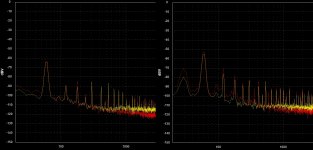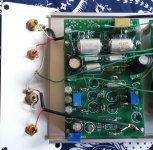AD8429 could be bit nicer I thought, cheaper also, but its not breadboard friendly because SMD, still curious for testing it later on some PCB.
That's the cheap version of the AD8229 (not cheap!) which is what I am using. My FET source followers fix the noise current issue and allow small film caps for low frequency pole. I don't think you will see a large improvement on current noise with that part. The 8229 comes in an 8-legs version but it is $$$ for the 200C guaranteed operation. I have a few with bent leads that are easily straightened if you want PM me.
Is the difference between 8229 and 8429 only the 200°C operation ?
i.e. they are the same die ?
Patrick
i.e. they are the same die ?
Patrick
Hmm I thought of JFET source followers too but I was hoping to avoid extras. Impossible when there are no 1nV class JFET input I-A chips available though, unless I will make a composite I-A as I did on first approach.That's the cheap version of the AD8229 (not cheap!) which is what I am using. My FET source followers fix the noise current issue and allow small film caps for low frequency pole. I don't think you will see a large improvement on current noise with that part. The 8229 comes in an 8-legs version but it is $$$ for the 200C guaranteed operation. I have a few with bent leads that are easily straightened if you want PM me.
I am not expecting a large bench result difference upon INA217 indeed but maybe interesting to listen to the 8229 after all. AD is always among the nicest subjectively.
i.e. they are the same die ?
Patrick
Same die, only the cerdip will do 200C. AKAIK the best plastic does 150C max. To be totally honest the THAT1512 for my circuit has 35nV referred to output noise which matters at low gain so two of them gets down to 25nV and totally removes the penalty of the low gain first stage in the last octave. With A weighting we're talking about tenths of a dB anyway.
Last edited:
Hello Scott, on your schematic from post #1 2sj74/sk170 are Toshiba devices, not LIS, correct?
I had a lot of them so I used them but it should not matter, the noise performance is up front.
Comparison of differential (left) vs. single ended (right) input. This is my low cost TT with a plastic unshielded Grado cart, the headshell wires are also exposed more than one might want. Still there is noticeable improvement by 10 dB (sometimes more). The 30Hz stuff on the right is a cycling air handler caught in the act.
Not as dramatic as hoped but it gets the line noise another 10dB below the floor of the LP. I suspect an all out effort could get much better.
Staying with the theme of being universal I replaced the RCA's on the TT with 3.5mm stereo jacks using tip and ring as plus and minus. Then a 3.5mm to stereo RCA cable becomes the differential connection and simply using a mono 3.5mm/RCA adaptor shorts the ring to ground at the TT to return to single ended RCA.
Not as dramatic as hoped but it gets the line noise another 10dB below the floor of the LP. I suspect an all out effort could get much better.
Staying with the theme of being universal I replaced the RCA's on the TT with 3.5mm stereo jacks using tip and ring as plus and minus. Then a 3.5mm to stereo RCA cable becomes the differential connection and simply using a mono 3.5mm/RCA adaptor shorts the ring to ground at the TT to return to single ended RCA.
Attachments
Last edited:
10dB is better than nothing for no wiring changes to optimise for CMRR. Would be interesting to see if a twist of two of the headshell wires would help (assuming enough slack for that).
Assume your TT to amp wiring is std coax?
Assume your TT to amp wiring is std coax?
Yes, for a short run from such a low impedance I don't think there will be much additional benefit. A differential amp is low on the to build list for now.Assume your TT to amp wiring is std coax?
Thanks for the graphs! Good to see that. Is the air handler noise coming thru the stylus, or is it electrical?he 30Hz stuff on the right is a cycling air handler caught in the act.
Clever idea....simply using a mono 3.5mm/RCA adaptor shorts the ring to ground at the TT to return to single ended RCA.

Thanks for the graphs! Good to see that.
AFAIK it's mechanical vibration, I might have missed dressing a wire in the box when I assembled it all.
Yes, I wanted to make something that did not require building a switch box, or worse, re-wiring to go back and forth. Now all possible configurations are just moving cables.
Long ago I wired up my TT arm with 4 wire shielded cable made for HHD heads. Ready for differential inputs. We've discussed this before, I think. I tried the balanced inputs of my soundcard, but it was not suited to the task. I'll borrow the stereo phone plug idea, for sure.
Hooked up the silent switcher in its own little cast AL box and everything works off of a single 5V Lithium pack. Looks like the TT wiring is the limiting factor in hum (the motor is on it's own DC wart).
Scott, if you have shielded RCA cables but you think the tone arm wires are the issue it could just be the cartridge. Depending on the type of turntable some cartridge can be the source; for example Grado's Gold plastic version has a table of compatible turntables for hum/no hum.
The standard is shielded RCA cables is enough.
The standard is shielded RCA cables is enough.
Scott, if you have shielded RCA cables but you think the tone arm wires are the issue it could just be the cartridge. Depending on the type of turntable some cartridge can be the source; for example Grado's Gold plastic version has a table of compatible turntables for hum/no hum.
The standard is shielded RCA cables is enough.
I just moved the TT off the workbench (lots of steel up against a wall full of wires) to a table in the middle of the room. And it looks better and below any audibility issues, I'm at ~500nV RTI.
Just an update, rewiring the inputs with Mogami miniature mic cable fixed the microphonics (so it wasn't the caps) one might want to dab them with a little silicone goop anyway. I'm done on this for now.
The box is one of those slide together extruded things at little bit of a pain because if you put your connectors on an end panel they have to slip under the bottom plate to slide the whole thing together. After going to BA I realize my build standards are not up to a lot of you folks but here is the input side and one channel. Yes the soldering iron brushed one of the 75nF caps the same cap on the other side had to be replaced. Only 1 or 2 components needed to be added so I saw no need to rev the board. There are a few things on the bottom.
The unused space had a couple of TO72 to TO92 adaptors that I was going to cut off the third unused board if I wanted to hand match some input devices from singles. The third board was populated with socket pins and I used it to pretest all the parts of the pre-amp before I stuffed the two channels.
After looking at my own picture, should I have used isolated RCA's and been more religious about the grounding? The noise floor seems to be no problem for me.
Over the last two evenings I threw lots of super disks at it with no problems at all. I somewhat enjoyed for the first time the Beethoven's 23 piano sonata on RCA RDC-4 45RPM direct to disk even though it is a note perfect from memory performance. This is considered by some the finest piano recording (not necessarily performance) ever. What I get on the finest LP's is front to back and side to side imaging that I don't remember from the past. I need to go and compare it to some other systems before I can make a final conclusion. One thing for sure the entire RIAA network as a shunt compensation on a current out input stage (simple transconductance) has no phono overload issues that I can see (or measure).
The unused space had a couple of TO72 to TO92 adaptors that I was going to cut off the third unused board if I wanted to hand match some input devices from singles. The third board was populated with socket pins and I used it to pretest all the parts of the pre-amp before I stuffed the two channels.
After looking at my own picture, should I have used isolated RCA's and been more religious about the grounding? The noise floor seems to be no problem for me.
Over the last two evenings I threw lots of super disks at it with no problems at all. I somewhat enjoyed for the first time the Beethoven's 23 piano sonata on RCA RDC-4 45RPM direct to disk even though it is a note perfect from memory performance. This is considered by some the finest piano recording (not necessarily performance) ever. What I get on the finest LP's is front to back and side to side imaging that I don't remember from the past. I need to go and compare it to some other systems before I can make a final conclusion. One thing for sure the entire RIAA network as a shunt compensation on a current out input stage (simple transconductance) has no phono overload issues that I can see (or measure).
Attachments
Last edited:
Axial components mounted vertically! My brother! Good on ya.
BTW my PCB CAD package strictly enforces pin number connectivity on all components, even bidirectional/symmetric components like Rs and Cs. So I use a schematic symbol that reminds me which end is the probeable/alligator_clippable one (from topside) and which is not. Example below.
_
BTW my PCB CAD package strictly enforces pin number connectivity on all components, even bidirectional/symmetric components like Rs and Cs. So I use a schematic symbol that reminds me which end is the probeable/alligator_clippable one (from topside) and which is not. Example below.
_
Attachments
Axial components mounted vertically! My brother! Good on ya.
_
I always do it to save space and/or have an efficient SMT/leaded option. In our old modular op-amps I don't think a single resistor was mounted any other way.
- Home
- Source & Line
- Analogue Source
- A simplified universal differential or single ended phono preamp


